Persian Influence on Greek Culture
The ancient Persian and Greek cultures did not exist in isolation. There was cross-fertilization. The present article describes several aspects of Persia's influence on Greece.
Introduction
The first part of this article is not to read, but to look at:
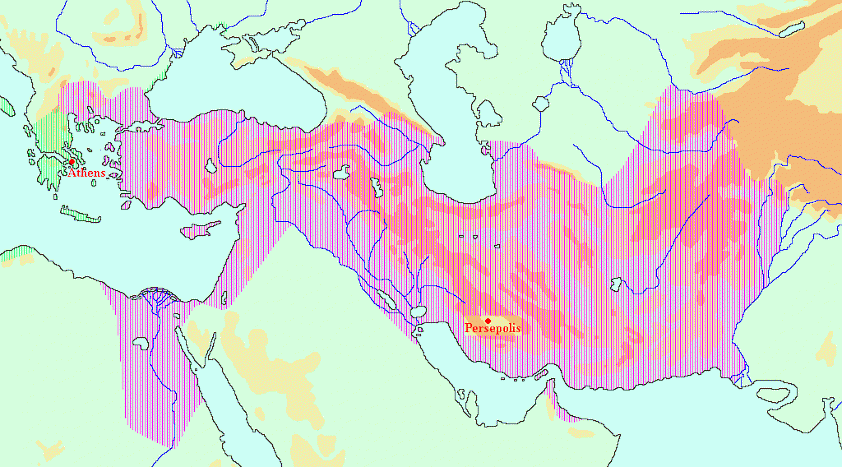
We see the extensive Achaemenid Empire (pink), stretching from the Indus in the east to the Mediterranean Sea in the west. Beyond the Aegean Sea, almost at the left edge of this map, we see a green area that consists of several islands and city-states, which have not yet decided whether they are one country or not. That is Greece.
Now it is remarkable that there have been more scholars who have studied the fuss and bustle on the northwestern border of the Achaemenid empire than researchers who have analyzed the world power itself. Of course, there are good reasons for this situation. Greece is relatively close to western Europe, where Greece had, since the age of the great art historian Johann Joachim Winckelmann (1717-1768), a more or less privileged status as the cradle of western civilization. Another reason is that the impressive Greek collection of literary, scientific and other texts has survived, whereas there is no such collection from Persia.note Moreover, in their historical writings, the Greek authors make it clear that the Persians are a mere bunch of decadent, effeminate barbarians, natural slaves that could be ignored in the history of mankind. The Greeks themselves had the best culture and there was simply nothing that other civilizations could add. Western scholars have long accepted this judgment.
This almost hostile attitude has long existed in Europe, together with a fascination for all that was strange and unknown, such as the mysterious Orient. Because of this combination of fascination and suspicion, questions about the exact interaction between the two cultures are not only interesting, but also necessary. One must see further than the end of one's nose.
When one studies the past, it is important to understand that no event, nation, or culture exists in isolation. Empires, ideas, and societies are influenced by the empires, ideas, and societies surrounding them. It is the conviction of the author of this article that exchange always exists, albeit on different levels and with varying intensity. Even when those involved deny this influence.note
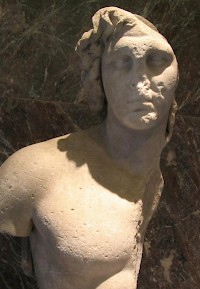
Let's return to the Greeks and Persians. Many scholars have researched Greek influence on the east, especially in the era after the conquests of the Macedonian king Alexander the Great (r.336-323). It is about time to to analyze the other direction of cross-cultural influence. That this remains an odd subject, is proven by the lack of literature on the subject; if the question about Persian influence is posed, it is usually in a footnote. It is, however, the main subject of the present article.
We shall discuss the question whether the Athenians, in the age after the Persian Wars (say after 479), have adapted Persian ideas on the fields of architecture and government. We shall discuss oriental influence on architecture, concentrating on the Odeon of Pericles, the Prytaneum, the Parthenon frieze, and the caryatids. After this, we will investigate whether there is similar influence on the management of the Athenian Empire, the Delian League. But first, we will have a quick look the most important events during the period under consideration.
History
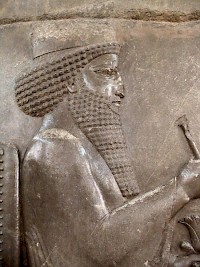
In 547 (or a few years later), the Persian king Cyrus the Great conquered the region that is now called Turkey. His son Cambyses went on to add Egypt to the Achaemenid Empire (525 BCE). Under his successor Darius I the Great (r.522-486), the Persians for the first time invaded Europe, where Thrace was subdued.
Since the days of Cyrus, the Greek towns in western Turkey - usually called the Ionian cities - belonged to the Achaemenid Empire, but in 499 they decided to revolt against those that had been their rulers for almost half a century. The men who ruled the Ionian towns on behalf of the Persian kings were expelled, and the help of the mainland Greeks was invoked. Although Athens sent a force to help the Ionians, the rebels were brought to heel.
According to the Greek researcher Herodotus of Halicarnassus, the Ionian revolt led king Darius to punish the Greeks who had supported the rebels. In 492, general Mardonius conquered Macedonia, and in 490, Datis and Artaphernes added the islands in the Aegean Sea. At the end of the summer, they led a punitive action against Athens, which ended in disaster in the battle of Marathon.
This battle meant a boost for the Athenian self-confidence, and the city became even stronger after the discovery of silver ore near Laurion. The new affluence was used to build a large navy.
In 480, the Persian king Xerxes (486-465) decided to avenge his father's defeat at Marathon. With a huge army and a large navy he invaded the Greek mainland, and defeated his enemies at Thermopylae. Thessaly and Boeotia were added to the Persian possessions and Athens was captured. However, the Persian navy was badly damaged when it encountered the Greek navy in the Athenian harbor (naval battle of Salamis). Xerxes was forced to return. He left the war to general Mardonius, who sacked Athens but was defeated in the summer of 479 near Plataea.
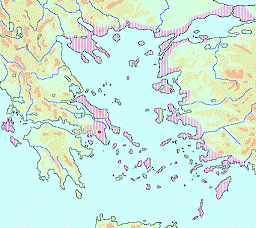
Two years later, the Athenian statesman Aristides organized those Greek towns of Ionia and the mainland that wished to continue the struggle in a new alliance, the Delian League. However, during the following decades, Athens, originally only the first among equal towns, started to regard the members of the League as its subjects. Because she was economically and military very strong, and became even more powerful because she now controlled an empire, Sparta, the leader of the other Greeks, became afraid.
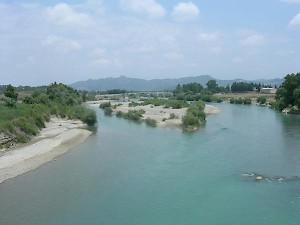
In 461, war broke out between Athens and Sparta. In the meantime, Athens was still at war with Persia. Sometimes, the Athenians were successful (e.g., at Eurymedon in c.468), and sometimes the Persians were victorious (e.g., in Egypt in 456). For a dozen of years, the Athenians had to cope with two enemies at the same time, but in 449, the hostilities with the Persians ceased. Three years later, Sparta and Athens concluded a treaty. This might have been the moment to dissolve the Delian League, but the Athenians refused to do so, and in spite of minor troubles, its members supported Athens in a second war with Sparta, which broke out in 431, lasted until 421, and was won by the Athenians.
However, in 415, Athens attacked Sicily in the far west and supported Amorges, a rebel in the Achaemenid empire. Although the Sicilian expedition ended in disaster, Athens still might have survived; however, the intervention in the Persian sphere of influence led to an alliance between Sparta and king Darius II Nothus. Several member states of the Delian League now revolted and Sparta received a powerful navy. In 404, Athens had to surrender and the League was dissolved.
Persia now regained the Ionian towns, but did not enjoy them uncontested. The Spartan king Agesilaus invaded Asia, where he remained successful until 394, when he was recalled by his government because Persia was now supporting Athens. For almost half a century, the Persians were able to retain their Asian possessions, simply by keeping the Greeks divided.